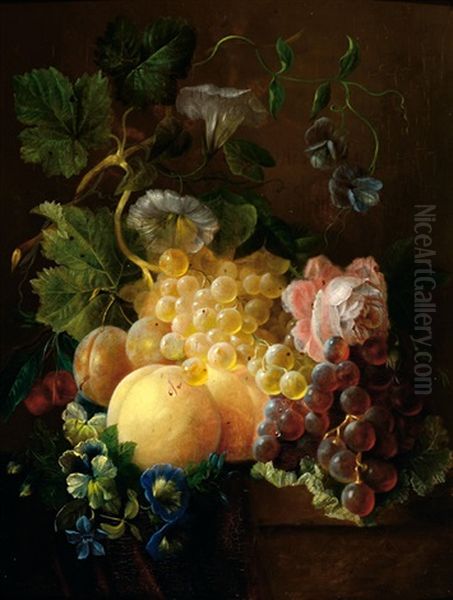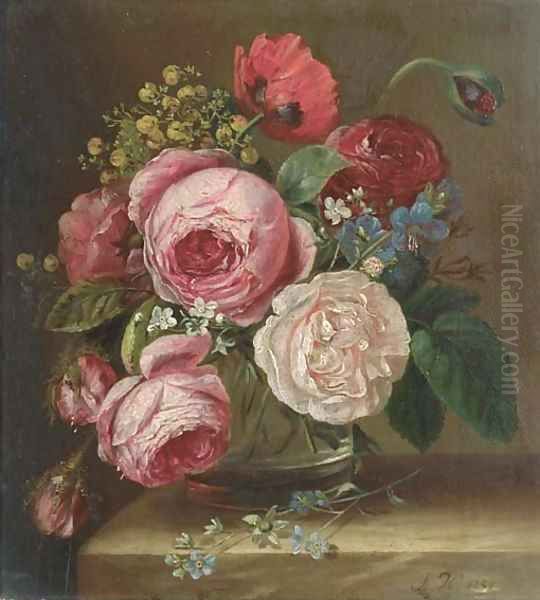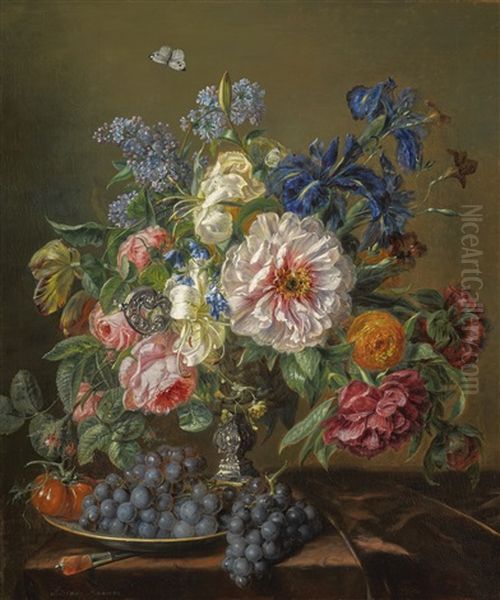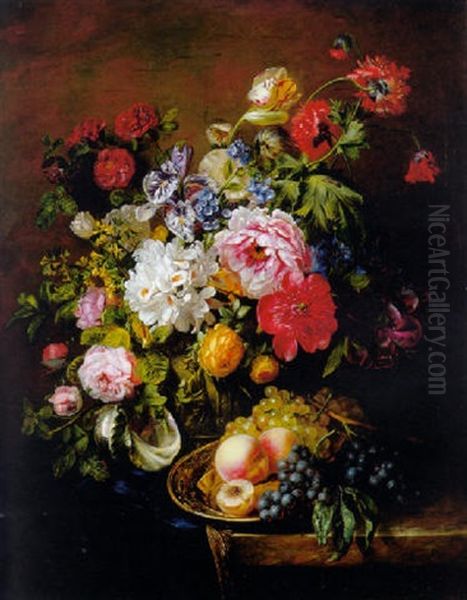
Adriana Johanna Haanen stands as a significant figure in the rich tapestry of 19th-century Dutch art. Born into an artistic family and flourishing in an era that saw a resurgence of interest in still life painting, Haanen carved a distinguished career for herself, becoming renowned for her vibrant and meticulously detailed depictions of flowers and fruit. Her work not only captured the ephemeral beauty of nature but also reflected the evolving artistic sensibilities of her time, moving towards a more naturalistic and less formal representation than her 17th-century predecessors.
Early Life and Artistic Lineage
Adriana Johanna Haanen was born on June 14, 1814, in Oosterhout, Netherlands. Artistry was deeply embedded in her familial roots. Her father, Casparis Haanen (1778–1849), was a multifaceted artist known for his work as a painter, etcher, and notably, a skilled paper-cutter. He also possessed a keen interest in art dealing and was an avid collector of old master prints. This environment undoubtedly provided a fertile ground for Adriana's burgeoning talent, exposing her to a wide array of artistic expressions from a young age.
The Haanen family was prolific in its artistic output. Adriana was one of several siblings who pursued artistic careers. Her brother, George Gillis Haanen (1807–1879), became known for his landscapes and genre scenes, often illuminated by candlelight, a style that earned him considerable recognition. Another brother, Remigius Adrianus Haanen (1812–1894), also excelled as a landscape painter and etcher, achieving international acclaim. Her sister, Elisabeth Alida Haanen (1809–1845), specialized in genre paintings and married the painter Petrus Kiers. This familial immersion in the arts provided both inspiration and a supportive network for Adriana as she developed her own artistic voice. While specific details of her formal training are sparse, it is highly probable that her initial instruction came from within her family, particularly from her father.
The Emergence of a Still Life Virtuoso

Adriana Johanna Haanen specialized in still life painting, with a particular focus on flowers and, to a lesser extent, fruit. Her approach was characterized by a remarkable technical skill, a keen eye for detail, and a vibrant use of color. She distinguished herself from the more rigid and formal compositions of many 17th-century Dutch Golden Age still life painters, such as Rachel Ruysch or Jan van Huysum, by imbuing her works with a greater sense of naturalism and a less constrained arrangement. Her bouquets often appear freshly gathered, with a lifelike quality that appealed to the sensibilities of her contemporaries.
From 1841 onwards, Haanen became a regular participant in the "Tentoonstelling van Levende Meesters" (Exhibitions of Living Masters). These exhibitions, held in various Dutch cities including Amsterdam, The Hague, and Rotterdam, as well as internationally in cities like Antwerp, Brussels, Bremen, and Paris, were crucial platforms for artists to showcase their work, gain recognition, and secure patronage. Haanen's consistent presence in these exhibitions indicates her active engagement with the art world and the growing appreciation for her talent.
Her skill and dedication did not go unnoticed. In 1845, she was elected as a member of the prestigious Royal Academy of Amsterdam (Koninklijke Academie van Beeldende Kunsten), a significant honor that underscored her standing in the Dutch art community. This membership provided her with further opportunities for exhibition and professional association.
Artistic Style and Signature Compositions
Haanen's paintings are celebrated for their lushness and meticulous rendering. She often depicted elaborate arrangements of flowers in vases, set against neutral backgrounds that allowed the vibrant colors and intricate details of the blooms to take center stage. Roses, tulips, peonies, and other garden flowers were frequent subjects, their petals and leaves captured with a delicate precision that conveyed both their beauty and their fragility.
Her compositions were typically well-balanced, showcasing a sophisticated understanding of color harmony and spatial arrangement. While some works featured opulent bouquets in ornate vases, others presented more modest arrangements, perhaps a few carefully chosen blooms in a simple glass or flowers scattered on a stone ledge or in a basket. This versatility demonstrated her ability to find beauty in various forms of natural presentation. She was particularly adept at capturing the textures of different elements – the velvety softness of a rose petal, the coolness of a marble tabletop, or the delicate transparency of a dewdrop.
Unlike some of her contemporaries who might have leaned towards more romanticized or allegorical interpretations, Haanen's primary focus seemed to be on the faithful and aesthetically pleasing representation of her subjects. Her works exude a sense of joy and appreciation for the natural world, rendered with a technical finesse that was highly admired.
The Oosterbeek Period and Maria Vos

A significant chapter in Adriana Johanna Haanen's life and career began in the early 1860s when she moved to Oosterbeek. This picturesque village, located near Arnhem, had become a popular destination for artists, particularly landscape painters, and was often referred to as the "Dutch Barbizon." Here, she formed a close personal and professional relationship with the fellow still life painter Maria Vos (1824–1906).
Haanen and Vos lived and worked together, eventually building a house they named "Villa Grada." This residence became a meeting place for many artists and friends, fostering a vibrant artistic community. The collaboration and companionship with Maria Vos were undoubtedly important for both artists. While each maintained her individual style, their shared passion for still life painting and their supportive environment likely contributed to their continued artistic development. Maria Vos, like Haanen, was a respected painter of flowers and fruit, and their association highlights the networks that female artists often formed for mutual support and encouragement in a male-dominated art world.
The Oosterbeek period was a productive one for Haanen. The natural beauty of the surrounding area, though not directly her subject matter, may have provided a serene and inspiring backdrop for her studio work. The artistic milieu of Oosterbeek, which included landscape painters like Johannes Warnardus Bilders and Willem Roelofs, would have offered stimulating intellectual and artistic exchange, even if their genres differed.
Recognition, Awards, and Patronage
Adriana Johanna Haanen's work garnered considerable acclaim throughout her career. Her paintings were sought after by collectors, and she achieved significant commercial success. It is recorded that her works could command high prices, sometimes reaching up to 1500 Dutch guilders, a substantial sum for the time. This financial success attests to the high regard in which her art was held.
One of the notable patrons of her work was King Willem II of the Netherlands, a known art connoisseur. Royal patronage was a significant mark of distinction and would have further enhanced her reputation. Her paintings were not only popular in the Netherlands but also found appreciation abroad, as evidenced by her participation in international exhibitions.

A crowning moment of recognition came in 1862 when she was awarded a gold medal at the Amsterdam exhibition for one of her exceptional still life paintings. Such awards were highly coveted and served as public affirmations of an artist's skill and contribution. Later in her life, in 1884, on the occasion of her 70th birthday, the Utrecht Art Society (Kunstliefde) bestowed upon her an honorary membership, a testament to her enduring legacy and respected position within the Dutch art establishment.
Teaching and Influence
Beyond her own prolific output, Adriana Johanna Haanen also contributed to the art world as an educator. She is known to have taught several students, guiding them in the techniques of still life painting. Among her notable pupils were Anna Abrahams (1849–1930) and Christina Alida Bleydenstein (1823-1885).
Anna Abrahams went on to become a well-regarded flower painter in her own right, associated with the Hague School. Her success reflects positively on Haanen's tutelage. The act of teaching demonstrates Haanen's willingness to share her knowledge and foster the next generation of artists, a role that was particularly important for female artists seeking guidance and mentorship. Her influence, therefore, extended beyond her own canvases to those she inspired and trained.
Contemporaries and Artistic Context
Adriana Johanna Haanen worked during a dynamic period in Dutch art. While the Hague School, with its focus on atmospheric landscapes and genre scenes (featuring artists like Jozef Israëls, Anton Mauve, and Hendrik Willem Mesdag), was gaining prominence, there remained a strong tradition and market for still life painting. Haanen and Maria Vos were among the leading female practitioners in this genre.
Other notable Dutch female still life painters of the era included Margaretha Roosenboom (1843–1896), who also specialized in flower paintings and achieved considerable fame, and Gerardine van de Sande Bakhuyzen (1826–1895), known for her delicate floral compositions. The work of these artists, including Haanen, demonstrates a continued appreciation for the meticulous observation and skilled rendering that characterized Dutch still life, adapted to 19th-century tastes.
Internationally, the 19th century saw a flourishing of still life painting across Europe. In France, artists like Henri Fantin-Latour were creating exquisite flower paintings that shared some affinities with the Dutch tradition in their beauty and realism, though often with a softer, more impressionistic touch. While Haanen's style remained rooted in a more detailed realism, her work was part of this broader European engagement with the still life genre. Her contemporaries in landscape painting, such as Barend Cornelis Koekkoek and Andreas Schelfhout, represented the Romantic tradition in Dutch art, which valued detailed observation of nature, a quality also evident in Haanen's meticulous still lifes.
Notable Works and Their Characteristics

While a comprehensive catalogue raisonné might be extensive, certain characteristics define Adriana Johanna Haanen's oeuvre. Her paintings often feature a rich profusion of blooms, meticulously detailed. Titles are typically descriptive, such as "Still Life with Flowers and Fruit," "Roses in a Glass Vase," or "A Bouquet of Summer Flowers on a Marble Ledge."
One can imagine the painting that won her the gold medal in 1862 was a particularly ambitious and flawlessly executed composition, showcasing the full range of her technical abilities and her sensitivity to color and form. Her works often display a strong sense of light, illuminating the flowers and creating subtle shadows that add depth and realism to the composition. The choice of flowers often included roses, tulips, lilies, carnations, and irises, arranged in a way that seemed both abundant and carefully considered.
Her paintings are held in various public and private collections, including major Dutch museums such as the Rijksmuseum in Amsterdam and the Teylers Museum in Haarlem. The presence of her work in these institutions underscores her historical importance and the enduring appeal of her art.
Later Years and Legacy
Adriana Johanna Haanen continued to paint into her later years, remaining dedicated to her craft. She passed away on October 8, 1895, in Oosterbeek, the village that had been her home and artistic haven for many decades. She left behind a significant body of work that continues to be admired for its beauty, technical skill, and contribution to the Dutch still life tradition.
Her legacy is multifaceted. As an artist, she excelled in a genre that has a long and storied history in the Netherlands, bringing her own distinctive style and sensibility to it. As a woman in the 19th-century art world, her success was a notable achievement, paving the way for future generations of female artists. Her role as a teacher further extended her influence.
The enduring appeal of Adriana Johanna Haanen's paintings lies in their timeless beauty. She captured the transient splendor of flowers with a skill and passion that continue to resonate with viewers today. Her work serves as a vibrant reminder of the rich artistic heritage of the Netherlands and the significant contributions of its female artists. Her dedication to realism, combined with an innate sense of composition and color, ensured her place among the respected painters of her era.
Conclusion
Adriana Johanna Haanen was more than just a painter of pretty flowers; she was a highly skilled artist who navigated the professional art world of the 19th century with considerable success. Born into an artistic dynasty, she honed her talents to become one of the foremost still life painters of her generation in the Netherlands. Her meticulous technique, vibrant palettes, and naturalistic compositions set her apart, earning her accolades, prestigious memberships, and the patronage of discerning collectors, including royalty.
Her life in Oosterbeek, particularly her partnership with Maria Vos and the establishment of Villa Grada, highlights the importance of artistic communities and supportive networks. Through her teaching, she passed on her knowledge, influencing artists like Anna Abrahams. Today, Adriana Johanna Haanen's works are treasured in museum collections and continue to be admired for their exquisite detail and enduring charm, securing her legacy as a distinguished master of Dutch floral still life. Her contributions enrich our understanding of 19th-century Dutch art and the vital role women played within it.